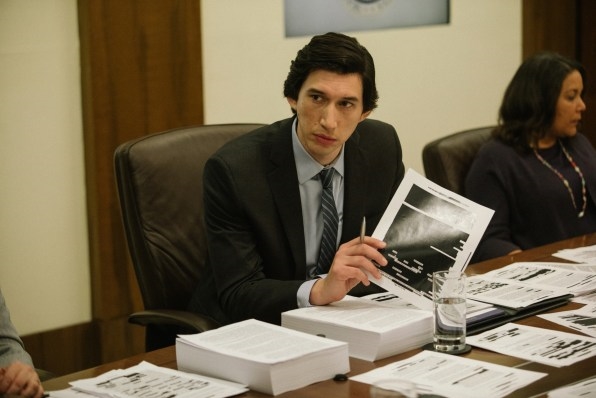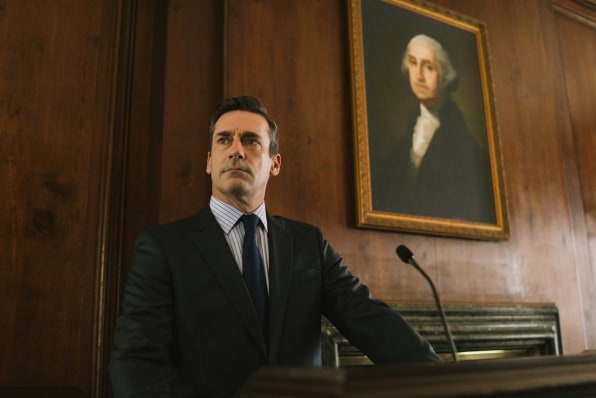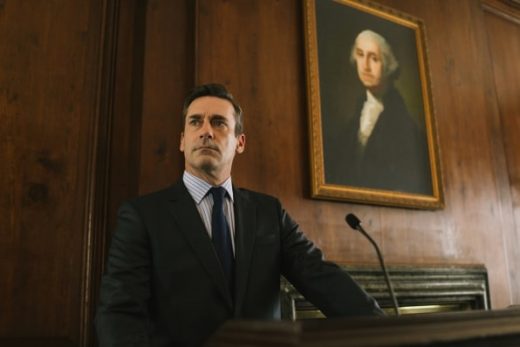‘The Report’ is a thriller about how we entered the post-truth era
In his directorial debut, Scott Z. Burns—the screenwriter of The Bourne Ultimatum, The Informant!, and Contagion—managed to condense a 6,700-page government report into a geopolitical thriller that’s actually thrilling. And, equally important, it’s the kind of honest analysis of governmental accountability that’s missing in our current post-truth era of “alternative facts.”
The Report follows Daniel Jones (Adam Driver), the former Senate staffer who was tasked to lead an investigation into the CIA’s “enhanced interrogation techniques” on al-Qaeda detainees following the attacks of September 11. The more Jones tugs at the strings of the case, the more entangled it becomes in cover-ups, misinformation, and political agendas. In real life, Jones spent five years digging and prodding (and resisting attempts to silence him) before his Senate Intelligence Committee report on CIA torture was released, in 2014—but only a 525-page, heavily redacted summary was made available to the public. TL;DR: The CIA spent tens of millions of dollars on a torture program that yielded intel the government already had, false information, or nothing at all.
It’s the kind of topic that screams “documentary” at first blush. Save for a few flashbacks of torture scenes, The Report largely takes place in various offices of government officials and the stuffy basement of the Senate building that became Jones’s HQ. But Burns manages to create a flashback-heavy narrative that moves along at the pace of the classic political thrillers from Alan J. Pakula (All the President’s Men, The Pelican Brief) and Sidney Lumet (Serpico, 12 Angry Men).
“That was a lot of work,” Burns says. “My editor, Greg O’Bryant, and I spent pretty much an entire, very hot New York summer in a very small room, shuffling and reshuffling the deck, trying to make sure that what we were doing would be understandable. That was where working on a film like The Bourne Ultimatum really helped me, because Jason Bourne is always being pushed forward in the moment while he tries to figure out what happened in his past.”
Burns explains the learning curve (and creative constraints) of his directorial debut, how he found the emotional charge for his unconventional hero, and the impact he hopes this film will have in the post-truth era.
The prologue to ‘The Report’
Burns started developing the idea for The Report after reading journalist Katherine Eban’s 2007 Vanity Fair report on the architects behind the CIA’s interrogation techniques. He began interviewing senators, members of the intel committee, and eventually Jones himself. The filmmaker originally approached his frequent collaborator, Steven Soderbergh, to direct, but Soderbergh convinced Burns he could do it himself.
“I think because he knew how much research I had done, he said, ‘You need to do this because there’s nobody who’s going to be able to catch up with you,’” Burns says. “The great thing about having done four movies with Steven is I’ve had the opportunity to spend about 200 days on set [with him], staring over his shoulder.”
In addition to the learning curve of being a first-time director, Burns was also hit with the perennial problem for filmmakers: financing. The Report was initially set up at HBO, where Burns says they were willing to make it for $18 million on a 48-day shoot. When HBO decided not to move forward with the project, Burns found distribution with Amazon Studios and a new production partner in Vice—but with a budget of $8 million and a 26-day shoot.
“I think of, like, a football analogy: If you know you don’t have a passing game, then don’t throw the ball,” Burns says of learning how to work with limited resources. “I better figure out a way to have some really great running plays, and when you get to give the ball to Annette Bening and Adam Driver, you just have to make sure that that’s what you’re in the service to.”
Part of what Burns tasked Driver with was creating a fully realized portrait of Jones without the crutch of a backstory or insight into his personal life.

[Photo: Atsushi Nishijima/Amazon Studios]
The unconventional hero
With Jones, Burns took a unique approach to the classic cinematic hero. In The Report, we see how subsumed Jones becomes in his work—much like Jessica Chastain’s CIA analyst in Zero Dark Thirty, who is singularly focused on hunting down Osama bin Laden. There are only three scenes in The Report where Jones is not in his or someone else’s office—a business lunch and two scenes where he’s jogging—but those turn into business meetings anyway. We don’t see Jones’s apartment, friends, family, or anything else from his private life. The only sliver we get of Jones’s off-hours existence is a brief reference at the beginning of the movie to a relationship that failed because he was working too much.
“I didn’t feel that it was that interesting to go and see that. We know what that scene looks like. I didn’t want the emotional charge of the film to come from that,” Burns says. “I love Serpico, but the parts of Serpico that I think I like the least are the relationships because it’s basically Serpico being neglectful.”
Burns wanted to root The Report in Jones’s obsessive pursuit of the truth and not necessarily the havoc that obsession may have wrought on his personal life.
“The way that I always think about Dan’s mission is: He was a guy who was given this very dusty blueprint and set off into a workshop to build something. About five years in, he looks up at what he’s built and he realizes it’s his own gallows. And that’s what I told Adam the first time we met—that that’s what I thought the voyage of this character was,” Burns says. “It pointed us towards, let’s think about his commitment to work, his obsessive nature. I think sometimes in Hollywood we’re on the side of becoming very sentimental and overemotional about moments of human life.”

[Photo: Atsushi Nishijima/Amazon Studios]
The “crisis of accountability”
The Report could easily be seen as a bipartisan film. Although the CIA’s torture program started under the Bush administration, it’s not a story that condemns one side while exalting heroes on the other. Burns, who confides that he voted for Barack Obama twice, says it was important not to gloss over how Obama handled the controversial program that trickled into his own administration.
“He said, ‘It looks like we tortured some folks.’ But then he wanted to turn the page. As John Hamm’s character [Obama’s chief of staff, Denis McDonough] says, ‘Democracy is messy.’ We all have to make choices, and our leaders make choices about things,” Burns says. “But when you don’t hold people accountable, you allow a kind of culture to continue. It happens in the workplace. It happens in government. That, to me, became a story that I felt I had to tell as well.”
What Burns believes it comes down to is the “crisis of accountability,” which is in particularly stark focus in today’s political climate. That, of course, raises the question of how filmmakers in the future will analyze what’s happening now beyond hot takes.
“I do believe that the first draft of history is usually wrong, and films are not immune from that,” Burns says. “And I think if you look at early Vietnam War movies compared to later Vietnam War movies, we needed to have a moment as a society to really understand that. I think the same will be true of this moment. But I do think that walking around in this environment as any sort of storyteller, whether you’re a person with a keyboard or a guitar or paintbrush, or you’re a comedian, I do think that it’s hard not to live in the moment that we’re in and tell the stories that need to be told. So I hope that people will research the things and try and get them right and not play fast and loose with facts.”
Fast Company , Read Full Story
(36)


